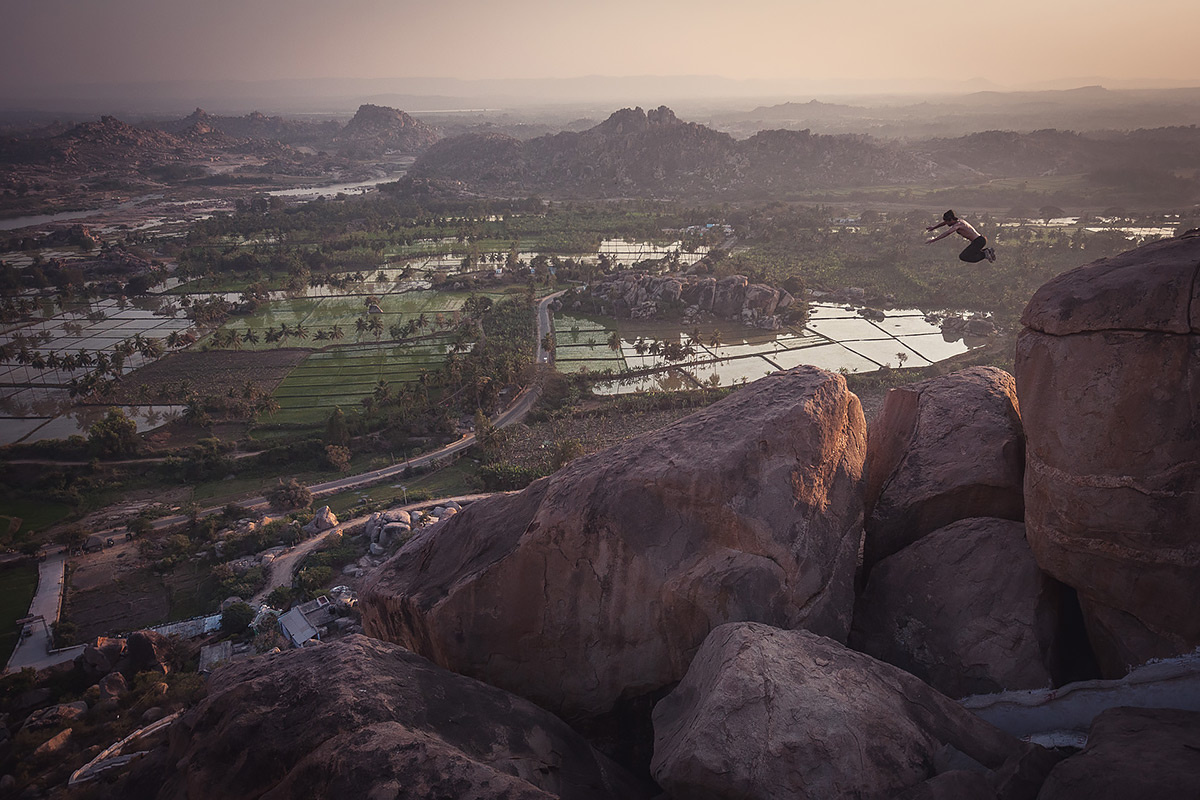In my photographic world, it’s sometimes nice to remind myself that I’m often little more than a monkey pushing buttons on a very expensive box.
In 2011, I went on an adventure with my close friend Thomas. His approach to travel is fairly unique, packing extremely light and taking great pleasure in moving slowly. This is a guy who once cycled alone across Tibet and loves lightness so much that he cuts the handle off his toothbrush.
When he suggested a five-week trip across India, I quickly agreed, not realizing that Thomas wanted to travel by motorbike despite me never having ridden one before. This would certainly be an adventure. We arrived in Chennai with me having only spent only two days riding around London on a tiny 125. We were about to set off across a huge country on a pair of 500cc machines: two glorious Royal Enfield motorcycles.
The highlight of our journey together was at Hampi, a Unesco world heritage site that features stunning plains littered with temples and boulders that stretch to the horizon. It is a Mecca for climbers and yoga enthusiasts, and the landscape is like something from a different planet.
One afternoon was spent climbing up one of the few pronounced hills not far from where we were staying. As well as a temple full of monkeys, there was an incredible vista on offer at its peak. On our way up, Thomas spotted a huge gap between two boulders that looked inviting. “I’m going to have a look at this jump,” he told me. “Maybe you could stand over there and take a photo.” I agreed, taking position and waiting patiently for him to warm up, assess the jump, and give me a signal.

Thomas at Hampi | andyday.com
The resulting photograph is perhaps that the best that I have ever taken and perhaps the best I will ever take. However skilled I might regard myself as a photographer, I often think about how little I was involved. Thomas trained for more than ten years to be able to even consider doing a jump like that. It was him that suggested the trip to India; he spotted the hill that we climbed, the gap between the two boulders, and even told me where to stand to get the shot. Sure, I picked the settings and pushed a button, but it’s a nice lesson in humility when I consider that Thomas was the person that made this photograph, and I played a relatively small role.
I’ve written a lot about parkour photography and about the intention of conveying the relationship between the body and the environment. I think that’s an element that people sometimes forget when shooting lifestyle sports, becoming preoccupied with the body and forgetting that the environment — whether it be the ocean or the streets — are as much a part of the story as anything else. Parkour is a physical conversation with the terrain, and for me, the location is just as important as what the athlete is doing.
Another element that fascinates me is how I am, in effect, facilitating a self-portrait on behalf of the athlete. They have an abstract vision of how they want to be portrayed, seeking to create a memory for themselves that validates the work and discipline that they invest in their practice. The photograph becomes this unique mixture of the past blended into the present, of seeing yourself, and this weird, often satisfying disconnection that comes of seeing yourself as others see you.

Thomas at dawn, shortly after waking up on the roof of a temple, somewhere in India. Thirty minutes after I took this photograph, just as the sun came up, a yoga class took place beneath us.
To those outside of the sport, it can all seem incredibly narcissistic, and sometimes it is: certainly, there’s no end of athletic young men chasing likes and followers through feats of physical prowess. But with the part of parkour that has kept me close to the sport for more than 15 years, that narcissism is far less pronounced. Take Thomas, for example: he’s one of the earliest practitioners but doesn’t have an Instagram account and doesn’t use his real name on Facebook. The self-portraits that I create for him are valuable because of what they represent to him. They are about his journey as an athlete and a human being, not their currency in the superficial world of social media.
I guess what I like to remind myself is that photography isn't just about a binary of "the viewer" and "the viewed", whereby the photographer is some powerful artist that creates visions in front of his lens, summoned from a magical part of his or her brain. I think the images that I'm proudest of creating have come about through collaboration, relationships with amazing athletes, and friends who drag you along on incredible adventures.













Great story and an interesting point. In the end, it was teamwork that really got the shot.
Thanks Mike! Glad you enjoyed it. :)
Great article. Looks like a trip that you'll remember forever, and the story of it captured beautifully.
Thanks Tom. Kind words. :)
All I can say is your photography humbleness is only out ranked by your story telling ability.
Too kind! 😊🙏🏻 I think! 😂